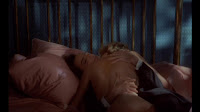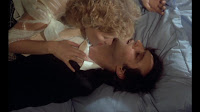Director: Alain Robbe-Grillet
Release date: 1983
Contains spoilers
Alain Robbe-Grillet was a French author and filmmaker associated with the Nouveau Roman trend. He actually wrote a novel entitled La Belle Captive in 1975. I’ll admit now that I haven’t read any of his work but I have seen reference to them in other works and understand that this film, first released in 1983, had little in common with the novel, using the name only and lifting perhaps some themes – indeed I have seen it referred to as more a spiritual sequel to the novel. But the themes and characters within this film also came from other Robbe-Grillet works, for instance Les Gommes.
Now, I will say that – as I have not read any of his literature nor seen any other of his films – I am coming at this as a Robbe-Grillet virgin. There will be deeper connections I have missed and I apologies in advance to Robbe-Grillet scholars. The film itself is less a vampire film and more has vampire themes which are played with and explored. I came across it after recommendation from my friend Leila who described it thus, “Imagine if David Lynch and Jean Rollin collaborated”.
There certainly was an element of Lynch in the precision of the imagery. If Rollin captures a dream within his work, trying to draw a particular dream from the dreamer’s point of view then Robbe-Grillet, like Lynch, uses consciously dreamlike imagery – sometimes with such force that it might be called heavy-handed. The film itself begins with a motorcycle ridden by Sara Zeitgeist (Cyrielle Clair) – the view of her, on her bike, becoming a binding motif through the film and zeitgeist means, of course, the spirit of the age. We also get the credits appearing in a frame upon a beach. We will explore this later but the layout of the image is based on the painting the Fair Captive by René Magritte.
We meet Walter (Daniel Mesguich) he is at a club, he is alone and worries that the organisation no longer uses him. He orders a vodka tomato juice – the bartender corrects him and calls it a Bloody Mary. He is watching a blonde woman (Gabrielle Lazure) and starts dancing with her. She is flirtatious but tells him she no longer has a name, if she finds it she’ll tell him, time no longer exists for her and that there is something wrong with her phone so she cannot give him a number. She tries his Bloody Mary but strongly dislikes it.
He gets a phone call from his chief, Sara Zeitgeist, and is told to meet her at the cemetery crossroads. When he gets back from the phone the blonde woman is gone. Walter’s voiceover, in which he suggests that he is an agent, and his dress are both very reminiscent of the stereotypical film noir detective. He meets Zeitgeist who tells him he must deliver a letter to the senator Comte Henri de Corinth and ensure that he is present when the letter is opened.
He drives along the highway and then sees something in the road. He stops and it is the blonde led on the highway, she has a wound in her leg, seems insensible and her hands are bound. Walter helps her into his car and decides to get help for her prior to finding the Comte de Corinth. As they drive, for a moment, their positions shift so that they look like a couple taking a romantic drive. He eventually finds a house called Villa Seconde and has the gate guards let him in so that he can use the phone.
He takes her into a room where suited men are stood around. He addresses them and they close in on him, their presence claustrophobic and threatening. As they discuss her, and one wants to buy her, they comment on her binding and call her the beautiful captive. A bartender is feeding her a drink and Walter demands to know what it is, taking it off her and smashing it to the floor. There is a red trickle on her mouth and, given her reaction to tomato juice was negative, we assume it is blood.
Walter calls out again for a doctor and a man introduces himself as Doctor Morgentodt (François Chaumette). He takes them upstairs to a room and Walter asks him for something to break the chain binding the woman’s hands. The doctor locks them in the room. We see her hands suddenly free and then her clothes vanish and they are together on the bed, she nuzzles tellingly into his neck. We see a beach and he screams himself awake.
Looking around he discovers that the room – and then the whole mansion – is decayed and broken – not the place of opulence he saw before. The chain has a name on it; Marie-Ange van de Reeves. His neck has blood on it and, it seems, punctures. He decides to continue his mission but, in a café, he sees a newspaper headline that says the Comte de Corinth’s fiancée has been kidnapped – there is a picture of Marie-Ange. The café girl thinks it odd that de Corinth is reported as not knowing his fiancée’s name.
The film uses repetition, especially using Magritte’s symbolism and art. This repetition is purposeful (as Robbe-Grillet uses such a device in much of his work) and knowing. The repeated finding of bloodied shoes is commented on by the police inspector (Daniel Emilfork) we meet who points out that they have three of a pair. When, eventually, Walter gets to the Comte de Corinth we find that the man is dead, punctures in his neck.
Comte de Corinth is interesting and clearly a multilayered symbolic figure – as is everything within the film. In 1797 Goethe wrote the poem the Bride of Corinth – which introduced (as far as I am aware) the first female vampire in Germanic poetry. The Bride, incidentally, gives a gift of a golden chain at her wedding, much like the one Marie-Ange wore and Walter now has in his possession. Further Comte de Corinth appeared in an earlier Robbe-Grillet work. In the book “Robbe-Grillet and Modernity: Science, Sexuality and Subversion” by Raylene L Ramsay it is pointed out that Corinth “Is an expert at underwater hunting with a harpoon and joins a series of maiden hunting and target practice on female figures”.
The Inspector tells Walter that Marie-Ange was not the kidnapped fiancée but, in fact, a girl who died on a beach, of a harpoon wound ‘accidentally’ inflicted by de Corinth some six or seven years ago. The sado-masochistic component that can be found in some of Robbe-Grillet’s work is perhaps referenced in the piercing of the thigh but other symbolism comes to mind. She is almost the female aspect of the wounded king – hence Walter becomes a grail knight. The fact that it is her thigh which is pierced carries more than a hint of virginity lost. The piercing fits in with vampirism, bringing to mind the idea of the stake through the heart, subverted to a more obviously sexual symbolism due to the location. Given the use of the beach as the place where the injury was originally inflicted I was also reminded, a little, of the finding of the vampire buried on the beach in the Blood Spattered Bride and, of course, of Jean Rollin generally as the beach is a symbol he often uses. In many respects, whilst she clearly drinks his blood, Marie-Ange (or Marie Angel) is stealing away Walter’s spirit or soul, causing his obsession (revealed in the repetition) that is reminiscent of the OCD elements displayed by the folkloric vampire.
Magritte used a beach and the set up of an easel and picture in the painting the Fair Captive as well as well as the Human Condition and, in many respects, Robbe-Grillet makes this a posthumous collaboration with the artist. Variants of the pictures become a theme within the film with the ball seen in the Human Condition replaced with Marie-Ange’s bloodied shoe. From postcards to paintings hung on the wall, Magritte haunts Walter and, when his brain is scanned at one point, Magritte’s images (such as bowler hat wearing men) fill his psyche.
I am sure that I have only scratched the surface of this psycho-sexual drama, which sees Marie-Ange as both vampire (supernatural) and vamp (femme fatale) and thus reaches back and touches the cinematic roots of the genre. It is truly an exploration piece and one that demands more than a single watch to get the most from it. A casual viewer might pass it off as pretentious (and I guess in some respects it is) but it is deeply fascinating once you realise the depth of reference and symbolism. 7 out of 10.
The imdb page is here.
Thursday, April 29, 2010
Subscribe to:
Post Comments (Atom)




























4 comments:
Robbe-Grillet - YEEHA!
But if you're going to get all avant-garde, then what about a review of Ruiz's NUCINGEN HAUS (2008)?
I just had a look-see and it seems to be ghost orientated so it wouldn't get on the blog... however it looks v. interesting and I mayn well try to track it down.
Incidentally, its good to hear from you Edna
Well, it's a case of CARMILLA-inspired vampiric ghosts. Surely merits a "VAMP OR NOT?"
Edna lives.
In that csae, on your say so, I'll try and search it out and give it the old 'Vamp or Not?' - how long that'll take is up in the air, but I hope not too long.
Post a Comment